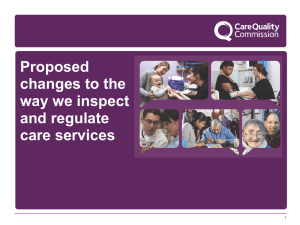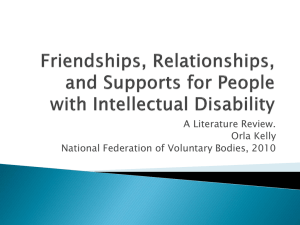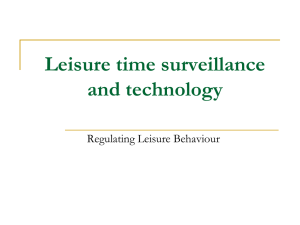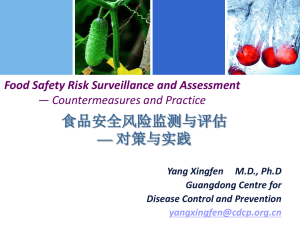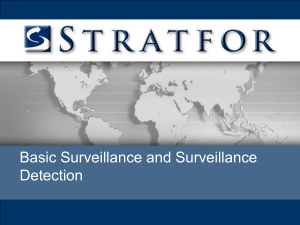Including People with ID in National Health Surveillance
advertisement
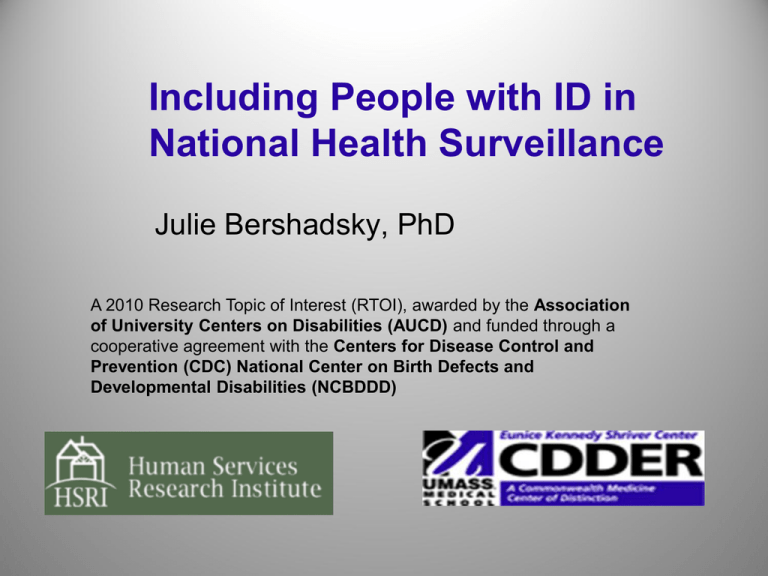
Including People with ID in National Health Surveillance Julie Bershadsky, PhD A 2010 Research Topic of Interest (RTOI), awarded by the Association of University Centers on Disabilities (AUCD) and funded through a cooperative agreement with the Centers for Disease Control and Prevention (CDC) National Center on Birth Defects and Developmental Disabilities (NCBDDD) Team Members Human Services Research Institute (HSRI) Val Bradley, MA Sarah Taub, MA Julie Bershadsky, PhD UMMS (CWM) Center for Developmental Disabilities Evaluation and Research (CDDER) Alexandra Bonardi, OTR/L, MHA (PI) Emily Lauer, MPH Steven Staugaitis, PhD Courtney Noblett, MPH People with Intellectual Disability Living in the U.S. • Prevalence: 1.0-1.5% (~4 mil. people) of intellectual/ developmental disability (ID) in the non-institutionalized U.S. population. • Population shifting to community based since 1970’s • Ageing population, increasing prevalence of chronic conditions Health of People with ID: What we know People with ID are more likely to: • Live with complex health conditions • Have poorly managed chronic conditions, such as epilepsy • Have limited access to quality health care and health promotion programs • Receive some cancer screenings at lower rates than the general population • Be obese • Have undetected vision and hearing problems • Have mental health problems and potential over-use of psychotropic medications Public Health Surveillance and Health Disparities “We’re invisible in the data. We can’t make people believe we need more services if we don’t have data to back us up.” Participant – Surgeon General’s Conference on Health Disparities and Mental Retardation 2001 Surveillance Gaps • Rate of people with ID in population falls dramatically from school-age to post-school age young adults. • Institutionalized populations are not usually included in national surveys. People with ID who live in larger group settings or in prisons are excluded. • Information on ID is not systematically collected in US health surveys. When people with ID live in the community, they are not identifiable in the population. Specific disparities they experience cannot be detected. • People with mild ID (IQ, 50-70) may be underestimated because they receive services outside of traditional monitoring systems. • Operational definition for ID varies across data systems, limited capacity for aggregation or benchmarking • People with ID may be reluctant to self-identify as having ID Key public health questions 1.What is the relative health status of adults with ID? 2.What are their major health risks, and how do the risks vary for different subgroups of this population? 3.How do access to and quality of health care relate to health outcomes for this population? AUCD/NCBDDDS Cooperative Agreement RTOI Health Surveillance of Adults with ID 1. Define ID (“Who are we talking about?”) 2. Compile and synthesize a knowledge base (“What are we talking about?”) 3. Extend past analyses of existing data sources that capture health information for people with an ID… 4. Pilot state or regional demonstrations 5. Develop sustainable approaches to expand surveillance 2010 RTOI: Health Surveillance in Adults with Intellectual Disability 1.Operational definition of ID 2.Compendium of sources of data, including a critical review of reliability, validity, and utility, 3.Expand knowledge about the population not included in current sampling frames Input and guidance from the Project Advisory Group Who are we talking about? • Eligible for state DD/ID specific services (NCI) • Self-identify on national health survey (NHIS) • Receive SSI/SSDI because of an intellectual disability (SSA) • A diagnosis of a ‘related condition’ ~ Autism, Down Syndrome… (Medicaid/Medicare) • People who were identified with ‘MR’ in school? “Surveillance demands uniformity, simplicity, and brevity” (MMWR vol. 39/No. RR13) 1. Defining Intellectual Disability for Health Surveillance To date: Review of current definitions Summit: Developing an Operational Definition of ID Draft definition Presentation at AUCD Health Frontiers conference in May Comment period Definitions of Intellectual Disability ADMINISTRATIVE (used for eligibility / funding) • AAIDD • Developmental Disabilities Act (DD Act) • ICD-9, ICD-10 • DSM-IV, DSM-V • SSI/SSDI SURVEY • Current Population Survey and American Community Survey • National Health Interview Survey • Behavioral Risk Factor Surveillance System • Survey of Income and Program Participation Additional sample frames • ICF • Special Olympics • Metropolitan Atlanta DD Surveillance program • Pomona Project (range) Expert Summit to Define ID • Multi-stakeholder participation: Self Advocates and family members Researchers State ID/DD service providers Clinicians Input from Federal agencies • Pre-summit materials (review of current definitions of ID) • One day summit to develop draft (4-13-11) • Summit notes and draft definition Assumptions 1. Focus on adults with intellectual disability. 2. Focus on health surveillance, recognizing that health is one of many important areas of quality of life. 3. Health surveillance demands a representative population. 4. Ethical issues of labeling must be considered. 5. Definition primarily for health surveillance. Not intended for eligibility. Guiding Principles Applicable now and in the future Include a functional component (not solely based upon IQ score) Go beyond service eligibility definitions To the degree possible, identify (neurodevelopmental) cause of ID Refrain from putting a negative value on people with intellectual disabilities Mindful of current, ongoing, and any new data collection effrorts Working Draft Definition for Health Surveillance [#1] AND [#2] AND [#3] AND [#4] IQ score approximately 70 or below, OR a clinician has told the person that they have an ID, OR “related condition” with support need [Intellectual Abilities and Related conditions] needs formal or informal support [Adaptive behavior] diagnosed in the ‘developmental period’ [Age of onset] expected to need some help for their entire life because of intellectual limitations [Life-long] OR [#5] person is eligible for State or Federal public support programs because of intellectual disability [Support needs] Application of the Definition Apply working definition across data sources to identify population by: Mining current administrative or survey data and/or Tweaking current collection of information and/or New data collection (e.g. de novo survey) Pathways to identifying the population with ID 1.Eligible for services because of ID? 2.Test of intelligence, or determination by clinician? 3.Related condition and difficulties in learning? 4.Special education? Draft ‘Pathways’ model 1 State or Federal assistance or supports because of ID? N N 3 ‘Related Condition’? N 2 Clinician determination of ID? Y ‘Needs Support for ADL / IADL’? 4 Received Special Education services? Y Y ?Y? Y Onset during developmental period? N Reason? Y ID (MR) or ‘Multiple Disability including ID’? (IDEA definition) YES Autism, severe learning disability, or other related condition? ? YES ? Temporary Condition? N Population with ID for the purpose of Health Surveillance 2. Compiling a Knowledge Base Round 1: close to 120 data sources reviewed, both general and ID/DD specific ID/DD group uniquely identifiable? Included in larger disability group? Fields that identify or potentially identify ID/DD Possible to separate ID from DD? Inclusion and exclusion criteria Health-related measures Sample methodology Sample size Data collection methodology Known and potential linkages 2. Compiling a Knowledge Base End of Round 1: narrowed to approximately 40 data sources for further critical review Round 2: critical review Biases in sampling? Power? Response rate? Biases in health measures? Applicability of health measures Primary data: info reliable? Proxy used? Secondary data: inclusion/exclusion criteria? Info reliable? Usefulness? Potential for adaptation? Methodology? Linkage? 2. Compiling a Knowledge Base Currently at end of Round 2. Next steps: Compendium of existing data sources that can be utilized for health surveillance Recommendations on methodology for new surveillance efforts Contact Information Alixe Bonardi Alexandra.Bonardi@umassmed.edu Emily Lauer Lauer.Emily@gmail.com Julie Bershadsky Jbershadsky@hsri.org Sarah Taub Staub@hsri.org

